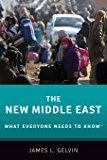|
Reviewed by Berkay Gülen, PhD Candidate in International Studies, University of Washington The author opens the book with a brief introduction on Middle East history after 1945 and argues that “the state system in the Middle East has been one of the most stable state systems in the world. It certainly has been more stable than the state system in Europe” (p.7). The reasons of the stable state characteristics in the region are the passage of time (formulating distinct national identities during the colonial period) and the support of great powers into the state system (namely, Britain and the United States). Exceptions of the stable state system are the shifting borders of Israel and the unification of North and South Yemen. In the second chapter, Gelvin examines the ways in which the Arab uprisings began and discusses five region-wide factors that made all states in the Arab world vulnerable to popular anger. Those are neoliberal policies, brittleness of Arab regimes, the so-called human rights revolution (transition from collective and economic rights to individual rights), demography, and global rise in food prices. The author also compares popular protests in Tunisia and Egypt and comes to a conclusion that Egypt lost the chance of political transformation because of its army’s major role, violent characteristics of popular protests, and economic demands of the people rather than democratic rights. The point the author missed to explain in this chapter is why Tunisia, in his own words, succeeded while Egypt could not whereas Tunisia and Egypt fall into the same category at the beginning of uprisings. The third chapter discusses the chronology of the Syrian uprising and its differences from the uprisings in Tunisia and Egypt, which are level of organization, non-existence of a Syrian epicenter for protests like Egypt’s Tahrir Square, the absence of independent associations, and the commitment of the Syrian army to the Assad regime (pp.53-54). Although it is possible to ask why there is a chapter devoted to the (failed) uprising in Syria, but not on Yemen and Libya, the book explores fair points about the Syrian case such as how the Assad regime militarize and sectarianize the uprising. One of the most helpful sections in this chapter is ‘Who’s Who’ part, which elaborates the opposition and pro-regime forces as well as the changing nature of those actors. The fourth chapter focuses on the rise and decline of ISIS while giving historical background on jihadist movements in the region. The author introduces ideological and theological references of ISIS and also discusses how ISIS was able to conquer territories in Syria and Iraq in a relatively short time. The military capabilities of the ISIS and the support of Sunni groups in Iraq are important, but Gelvin points out the most important reason as the collapse of the Iraqi army and the absence of military forces in the territories that ISIS captured quickly. The last two chapters of the book present a look at the US strategy in the Middle East during the Obama period and human security in the Middle East. Gelvin examines the principles of the Obama administration, which is “offshore balancing,” “the US policy to rely on regional powers in order to balance the hostile or disruptive states” (p.112-3). Lastly, the author shares statistics on life expectancy, literacy rate, population trend, poverty, education, and natural resources as well as examines the influence of those variables on Middle East politics in the 20th century. In sum, Gelvin’s book is a helpful source for the general public, as its title also indicates, and for the audience which would like to read an introduction to the region in the 20th century. Although it is a welcome addition to Middle Eastern studies, the advanced readers, such as graduate students working on the region may seek out other works. Nevertheless, the book still promises brief understanding and background information for undergraduate students. |


 The New Middle East: What Everyone Needs to Know
The New Middle East: What Everyone Needs to Know